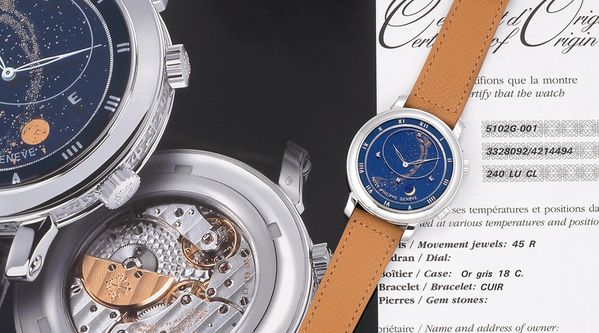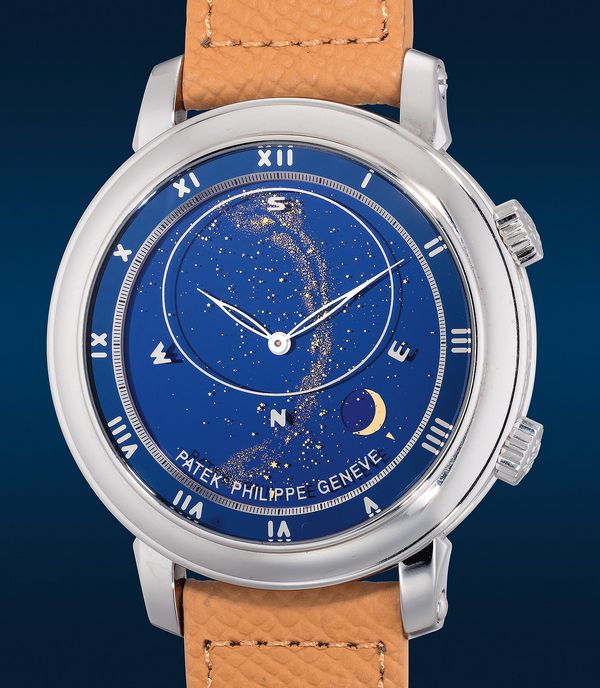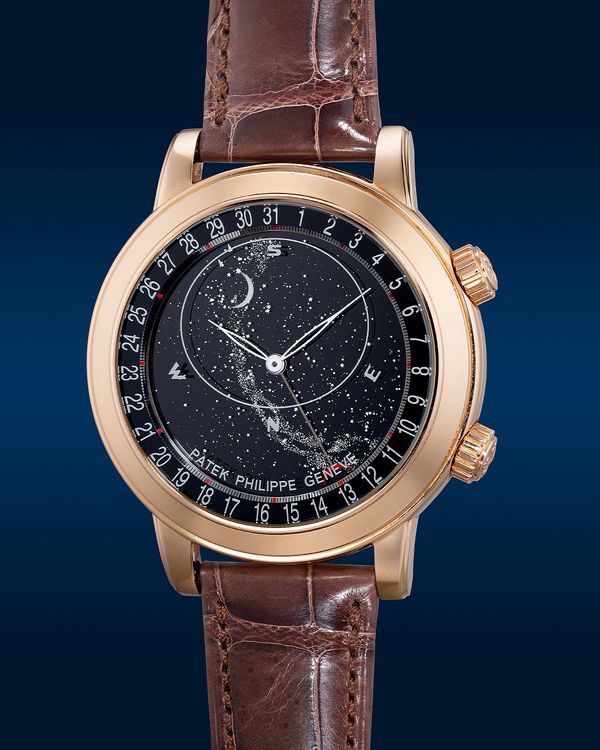The PHILLIPS Hong Kong Watch Auction: XVIII, takes place on May 24 and 25, 2024, at our West Kowloon headquarters. The auction includes more than 280 of the world's finest watches – and though we are loath to boast, we truly think it's one of the best catalogs we've ever put together. We'll be highlighting a number of the most interesting lots and stories featured in the sale over the next month, including the Patek Philippe Celestial ref. 5102G-001 featured below.
– By Logan Baker
Patek Philippe’s bread-and-butter has long been its complications, a fact we very recently covered in an-depth guide spotlighting the Philippe Stern era of leadership for the brand in the 1990s and 2000s.
Today we’re going to tighten our focus to dive into the unique and unusual series of Celestial watches by Patek Philippe. Incredibly complex, they represented something of a shift between eras for the family-owned Geneva watchmaking firm. Patek Philippe would gradually phase out its selection of smaller complicated timepieces (37mm and under) in favor of larger-than-life wristwatches, just like the 43mm and 44mm watches built under the Celestial name.
The Celestial series of watches is a fascinating one. You might have no idea of its exact functionality if you were just studying the aesthetics of it. The astronomical wristwatch is a simpler version of one of the most complicated Patek Philippe wristwatches of all time, the Sky Moon Tourbillon ref. 5002. The first Celestial, the ref. 5102P was introduced in 2002 in platinum, utilizing the now-signature celestial canopy for the dial. An 18k yellow gold version (ref. 5102J) would be added to the collection between 2007 and 2009. Less than 100 two-tone examples (ref. 5102PR) with platinum front and back bezels and an 18k pink gold caseband were also produced between 2009 and 2012.
A rotating depiction of the nocturnal sky in the Northern Hemisphere fully illustrates the gradual motion of the stars and Moon in space, along with the exact phases of the Moon. Three individual metallized sapphire crystal discs are seamlessly layered on top of one another to simulate the dynamic orbit of the moon and the passage of the stars, providing the watch with a remarkable sense of depth. The hours and minutes are indicated by two hollowed hands in white. An oval contour on the inside of the glass frames the portion of the sky visible from all cities sharing the same latitude as Patek Philippe's home in Geneva.
Understanding sidereal time is essential in understanding how the other astronomical indications work on the watch. The disc carrying the stars rotates once every sidereal day, which is measured by the time it takes a star to return to its zenith and is slightly shortter than a 24-hour day. The stars, of course, rise above and set below the horizon line on sidereal time. If a line is drawn from 12:00 to 6:00 on the dial, that line will represent the meridian overhead at the observer's location.
The sky chart rotates as does the moon indicating that not only captures the phases of the moon but also its position in the sky. As the moon phase aperture rotates, one can observe the point where it passes the meridian. A small yellow pointer is also set next to the large star on the dial that represents Sirius — the brightest star visible from Earth at night — allowing the observation of its individual meridian passage.
To achieve the highest possible exactitude for the astronomical displays, the engineers of Patek Philippe researched 25 trillion ratio combinations, highlighting the enormous horological challenge the watch represents. The movement is designed to rotate at different speeds, governing the multi-layered sapphire crystal discs that form the dial. A sapphire caseback allows a clear view of the self-winding caliber 240 LU CL, consisting of 301 hand-finished components with polished chamfers and screw heads, Côtes de Genève stripes, perlage, and engravings.
Exactly one decade after the Celestial’s debut, Patek Philippe introduced an updated version with the ref. 6102, in 2012. Interestingly, the ref. 6102 was technically preceeded by the creation of the unique ref. 5106R with pointer date that was produced by Patek Philippe for the Only Watch charity auction in 2009, where it was won by one Mr. Jean-Claude Biver.
The ref. 6102 remains in production to this day (in either 18k pink gold or platinum, or as the ref. 6104 in 18k pink gold with a baguette-set bezel and clasp) and is largely similar to the original ref. 5102, with slightly larger case dimensions and the addition of a pointer date complication on the periphery of the dial.
Additionally, unlike on the ref. 5102, the ref. 6102's casebands are no longer embellished with an engraved Calatrava cross motif but rather dressed down in a cleaner polished finish. The watch continues to be wound and set the same way, via the crown at two o'clock, while the astronomical functions are still adjusted by using the crown at four o'clock.
You can learn more, place a bid, and view the entire Hong Kong Watch Auction: XVIII catalog here.
About Phillips In Association With Bacs & Russo
The team of specialists at PHILLIPS Watches is dedicated to an uncompromised approach to quality, transparency, and client service. Phillips in Association with Bacs & Russo holds the world record for the most successful watch auction, with its Geneva Watch Auction: XIV having realized $74.5 million in 2021. Over the course of 2021 and 2022, the company sold 100% of the watches offered, a first in the industry, resulting in the highest annual total in history across all the auction houses at $227 million.
About Logan Baker
Logan has spent the past decade working in watch-focused media, reporting on every aspect of the industry. He joined Phillips in Association with Bacs & Russo at the start of 2023 as the department's Senior Editorial Manager. He splits his time between New York and Geneva.
Recommended Reading
The Imperial Patek Philippe: A Short Documentary
Why The Patek Philippe Ref. 5980 In Steel Changed Everything For The Nautilus
Same, But Different: Two Matching Pairs of Vintage Patek Philippe Worldtimers




